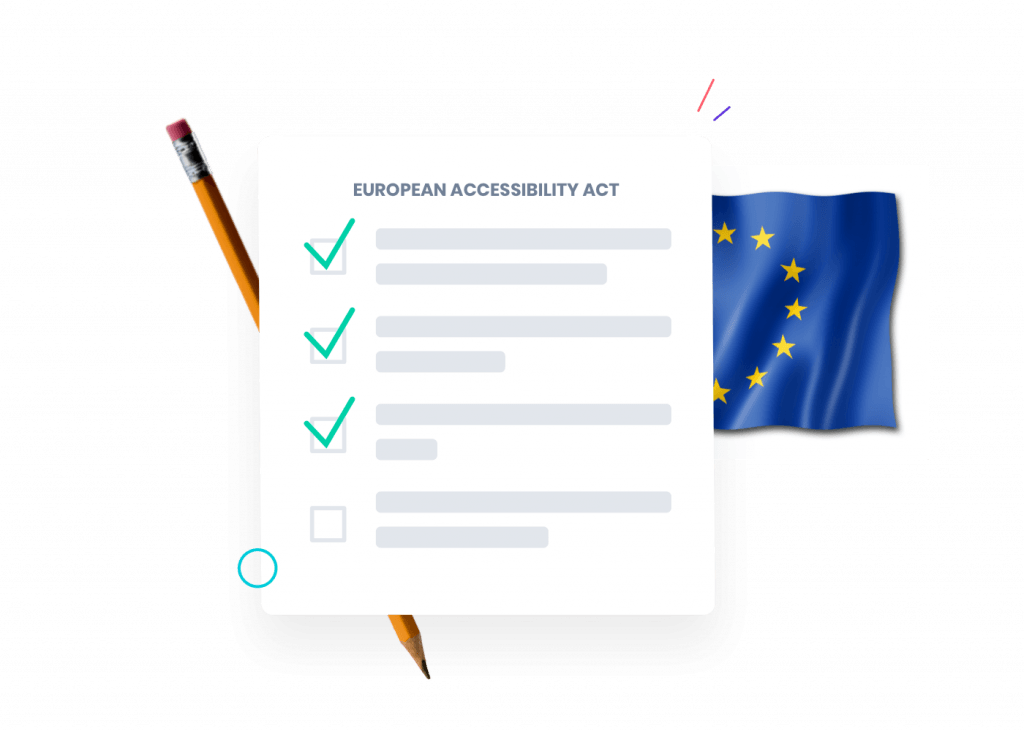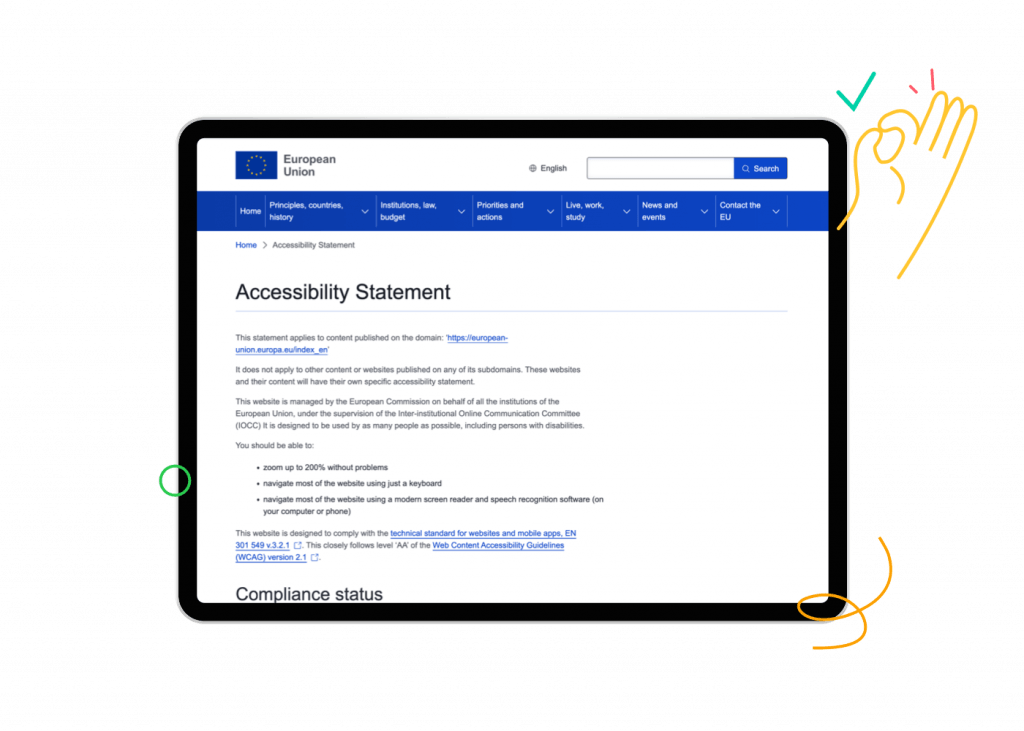Everything you need to know about the European Accessibility Act (EAA)

June 28, 2025, is the day: the European Accessibility Act 2025 (EAA) will come into effect across the entire European Union. From then on, many websites and webshops must be digitally more accessible for people with disabilities. We will tell you what the EAA means for you and how Combell, through its hosting family team.blue, is contributing to more inclusive e-commerce.
- What is the European Accessibility Act (EAA)?
- Which organizations must comply with the EAA?
- Which products and services must comply to EAA?
- Focus on e-commerce
- What and who is exempt from the EAA?
- Important deadlines and dates
- The benefits of EAA compliance
- How to ensure EAA compliance
- Follow our step-by-step plan to comply with the EAA
- Tip: make your website EAA-compliant with AccessiWay
- Frequently asked questions about the EAA 2025
What is the European Accessibility Act (EAA)?
The European Accessibility Act, also known as the European accessibility law, aims to make digital media such as websites, webshops, and apps more accessible and inclusive.
The European Accessibility Act does not introduce new standards. Instead, it is based on existing European and international standards for digital accessibility.
The Web Content Accessibility Guidelines (WCAG) 2.1 at level AA form the foundation for digital accessibility under the European standard EN 301 549. Under the EAA, websites, apps, and other digital tools must comply with these guidelines.

WCAG comes with four key principles:
In summary, digital tools and devices must be usable by everyone in our society.
With this European legislation, the EU aims to ensure that people with disabilities can both use and understand online content. Specific content must be optimally accessible via various technologies, such as laptops with touchscreens and speech recognition software.
EAA also for the private sector
The EAA is a result of the EU Web Accessibility Directive (WAD). Since December 2020, (semi-)government entities have been required to make their websites and other digital applications more accessible.
From June 28, 2025, the ‘EAA Accessibility 2025’ project will also impact the private sector. Once the European Accessibility Act takes effect, private sector businesses must ensure their websites, apps, and other (online) products are accessible.
The goal of the 2025 European Accessibility Act is to establish clear and equal rules for everyone within the EU.
On the one hand, the EAA ensures that products and services become more accessible for people with disabilities. On the other hand, businesses that adopt inclusive practices can operate more easily within the EU and attract more customers.
Why is accessibility important?
Because it is a fundamental and essential right. Statistics show that more than 80 million people in the EU live with a disability, a number that will only increase due to an aging population. This group should not feel excluded—everyone has the right to access technology and information.
The EAA promotes equal opportunities and gives businesses the chance to reach more customers by offering inclusive products and services. Accessibility is not only beneficial to society but also to the entire business sector.

Which organizations must comply with the EAA?
INTER, the Flemish expertise center for accessibility, describes the EAA regulations as follows:
"The EAA applies to an organization or company if it provides certain essential products or services:
- That consumers purchase.
- That consumers use.
A consumer is someone who buys a product or service for private use.
These products and services are necessary for people to participate independently in society.
- Examples include payment terminals, self-checkout machines, computers, smartphones, tablets, software.
- Examples include banking services, telephone services, sending messages via a smartphone, tablet, or computer, or purchasing something online through a webshop."
Which products and services must comply to EAA?
The European Union has compiled a list of online products and services deemed essential for people with disabilities.
According to INTER, these include:
PRODUCTS
Computers and operating systems
- Requirement: Both the device and the operating system must be accessible (hardware and built-in software).
Mobile devices
- Requirement: Both the device and the operating system must be accessible (hardware and built-in software).
Payment terminals and ATMs
- Requirement: Clearly readable screens, distinct buttons, accessible information for blind customers or customers with motor disabilities.
Ticketing systems, check-in kiosks, and ATMs
- Requirement: High-contrast screens for easy use, adapted input methods such as raised buttons and audio feedback.
Electronic readers (e-readers)
- Requirement: Both the device and the content must be accessible, for example, via a screen reader (software that reads content aloud).
Devices for watching television and other media
- Requirement: User-friendly menus, support for subtitles and voice control.
SERVICES
Electronic communication services
- Requirement: Customers with disabilities must be able to use all these services, including their websites and apps, with assistive tools.
Audiovisual media services
- Requirement: Accessibility via subtitles, audio description, and a user-friendly interface.
Banking and payment services
- Requirement: User-friendly design, clear language, and compatibility with screen readers.
E-book services
- Requirement: Accessible formats such as large fonts and screen reader support; platforms selling e-books must also be accessible.
Transport
- Requirement: Digital accessibility for services such as online ticket sales and check-in processes for trains, buses, trams, subways, coaches, airplanes, and boats.

Focus on e-commerce
At Combell, we focus specifically on the e-commerce aspect of the European Accessibility Act 2025.
A large number of websites and webshops will have to improve their accessibility. If you sell a product, offer a service, or process reservations, you fall under the EAA.
Specifically, this applies to all services where consumers can purchase something, enter into a contract or subscription, or make reservations that can be paid for afterward. In other words, many (online) businesses must review their tools—including online clothing stores, bookstores, learning platforms, hotel websites, digital television services, and telecommunication services.
What and who is exempt from the EAA?
Are you a company with (fewer than) ten employees and a turnover of less than 2 million euros? Then you are a micro-enterprise and the EAA does not apply to you.
There are also exceptions that apply to existing products and B2B sales. Are you a supplier of products that were already on the market before 28 June 2025? Then the new rules do not immediately apply, unless you make significant changes to the product or re-launch it on the market.
The EAA also does not apply to products and services that companies or organisations sell directly to each other (business to business).
There may also be a disproportionate burden. Is it much too difficult, too expensive or technically impossible to comply with the rules? Then you can request an exemption, but you will have to demonstrate very clearly why it is truly not feasible for your organisation.
Important deadlines and dates
🚨 June 28, 2025
- Services and new products covered by the EAA must be accessible from this date.
🚨 June 28, 2030
Important: the transition period for existing products ends on this date.
- Products already on the market before June 28, 2025, must also comply with EAA regulations starting from June 28, 2030.
- Not compliant? Countries may impose stricter enforcement measures, which can vary per EU country.
- Existing products that receive major updates or are relaunched before 2030 must comply by June 28, 2025.
What happens if you don't comply with the EAA?
Ignoring the Accessibility Act 2025 can have a negative impact on both your company and your reputation.
Some EU countries impose heavy fines that can be as high as 3 million euros. You may also face a recall campaign. In such a campaign, products or services are removed from the market until they meet the requirements.
Companies or organisations that commit very serious offences can be forced to suspend their business activities. There is a chance that you will (temporarily) lose the right to trade in the EU.
Although the financial consequences are significant, you should also not underestimate the impact on customer satisfaction. Companies that continue to offer tools that are not easily accessible run the risk of suffering reputational damage and losing customers.

The benefits of EAA compliance
Adjusting your products and services to the EAA Accessibility 2025 requirements may seem challenging, but it offers several advantages:
How to ensure EAA compliance
Technical adjustments
- Websites and mobile apps – Must comply with WCAG 2.1 AA standards, including:
- Alternative text for images
- Sufficient color contrast and readable typography
- Keyboard-navigable structures
- Well-structured forms and interactive elements
- Multimedia – Offer alternatives such as subtitles for videos and transcripts for audio content.
Development & design processes
- Inclusive design principles – Accessibility should be considered from the start of development.
- Regular audits – Conduct periodic accessibility tests to ensure continued compliance.
Organizational measures
- Accessibility policy – Outline your company’s accessibility commitments.
- Feedback mechanisms – Provide easy ways for users to report accessibility issues.
- Training and awareness – Educate employees about accessibility guidelines.
Include an EAA Accessibility statement
An EAA Accessibility Statement allows your company to communicate how inclusive and accessible your digital services and products are.
It contains clear and transparent information aimed at users, potential customers and regulators.

This is what you can read in the EAA Accessibility statement:
Follow our step-by-step plan to comply with the EAA
1️⃣ Identify relevant services
- Conduct a full inventory of your products and services, including websites, mobile apps, and physical locations.
- Determine which of these services fall under the European Accessibility Act (EAA).
2️⃣ Conduct an accessibility evaluation
- Analyze the current accessibility of both your digital and physical products.
- Use WCAG 2.2 standards as a benchmark to identify existing challenges and areas for improvement.
3️⃣ Increase knowledge and awareness
- Organize training sessions and workshops for employees on accessibility principles.
- Ensure that everyone understands the importance of accessibility and how they can contribute to an inclusive service approach.
4️⃣ Develop a detailed action plan
- Based on the evaluation, create a concrete plan with specific adjustments and improvements.
- Set priorities, establish clear timelines and deadlines for implementing necessary changes.
5️⃣ Implement the improvements
- Apply the planned adjustments, such as optimizing the user interface of your website or app.
- Provide accessible instructions and information across all communication channels.
6️⃣ Document and publish an accessibility statement
- Create a statement outlining the measures taken to improve accessibility.
- Explain how accessibility is structurally maintained within the organization and how users can report any issues.
7️⃣ Ensure accessibility and monitor progress
- Integrate accessibility into daily business processes, making it a permanent part of company policy.
- Conduct regular audits and evaluations to ensure continued compliance with the EAA.
8️⃣ Stay up to date with developments
- Keep track of the latest updates in accessibility laws and regulations.
- Continuously adapt your processes and policies to meet the most up-to-date requirements.
Tip: make your website EAA-compliant with AccessiWay
You can partner with an external provider to enhance the accessibility of your products and services. However, if you want a smooth and cost-effective implementation, you can rely on AccessiWay!
AccessiWay, part of team.blue (the hosting family behind Combell), makes your website accessible to all visitors by adding a widget that ensures:
The tool performs daily scans to ensure that the content of your site or shop is always optimised. Are you starting out with EAA and curious about how AccessiWay can help you?


